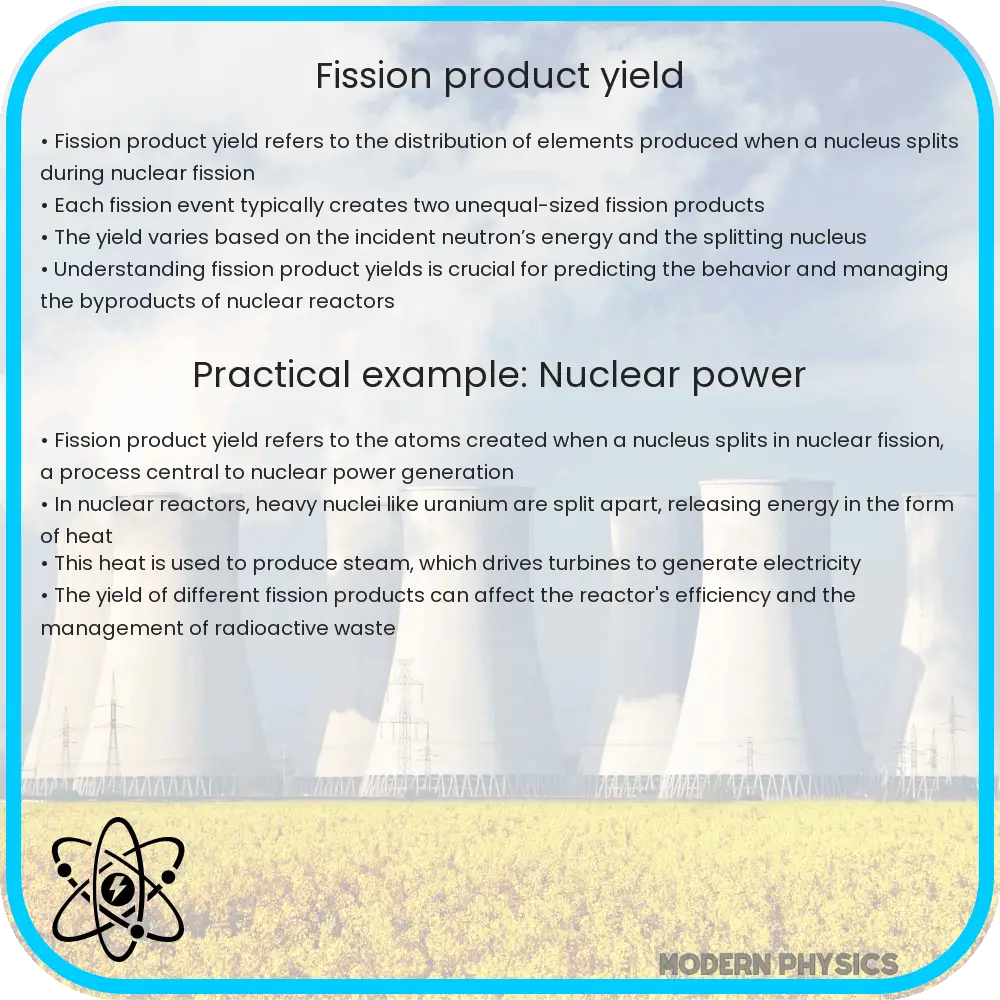Learn about fission product yield, the probability distribution of isotopes after nuclear fission, essential for predicting radioactivity and ensuring safety in nuclear power.

Introduction to Fission Product Yield
In the realm of nuclear physics, one critical concept often explored is fission product yield. This term pertains to the distribution and probability of formation of various isotopes as fission products after a nuclear fission event. These products are crucial not only for understanding basic nuclear reactions but also for gauging their practical applications and safety measures in nuclear power generation.
Understanding Nuclear Fission
Nuclear fission occurs when the nucleus of an atom splits into two or more smaller nuclei, oftentimes producing free neutrons and photons (in the form of gamma rays), and releasing a significant amount of energy. This process can occur naturally or can be induced artificially in nuclear reactors. A common example is the fission of uranium-235 (U235), which is a key reaction in most nuclear reactors.
Fission Product Yield: Definition and Importance
Fission product yield refers to the fraction of a fissioning isotope that forms a particular nuclide as a result of the fission process. This yield is usually expressed as a percentage and is fundamentally important for several reasons:
- Predicting Radioactivity: Knowing the yield helps in estimating the radioactivity and decay heat produced by the fission products, which are crucial parameters for the design and operation of nuclear reactors.
- Safety Measures: Accurate knowledge of fission product yields is important for handling, storage, and disposal of nuclear waste safely.
- Nuclear Forensics: The analysis of fission product yields can assist in nuclear forensics, helping to identify the source and type of fission material used in nuclear tests or incidents.
How Fission Product Yields are Measured
Fission product yields are determined experimentally by measuring the relative quantities of isotopes formed in a fissionable sample after it undergoes fission. Techniques such as mass spectrometry or gamma spectroscopy are commonly used in these measurements. Additionally, yields can also be estimated through theoretical models that simulate nuclear fission processes.
Yield Distribution and Chains
The distribution of fission products is not uniform. Two significant peaks, known as “light peak” and “heavy peak,” are generally observed on the yield curve of most fissionable isotopes. These peaks correspond to the fission fragments with mid-range mass numbers, typically around 90-100 and 130-140. Beyond these peaks, the yields decrease steeply for lighter or heavier fragments. This behavior underlines the complex nature of nuclear fission, influenced by factors such as nuclear shell effects and the energy of incident neutrons.
The fission products themselves undergo further transformations through beta decay, transforming into different isotopes and elements over time. The sequences of isotopes produced by successive beta decays are known as decay or fission yield chains. Tracking these chains is essential for understanding long-term radiological hazards and the decay heat associated with nuclear waste management.
Applications of Fission Product Yields in Energy Production
The management of fission products is key in the field of nuclear energy. Engineers and scientists utilize the knowledge of fission product yields to enhance the efficiency and safety of nuclear reactors. For instance, by understanding which isotopes generate the most heat and radiation, reactor designs can be optimized to absorb these effects efficiently. Similarly, knowledge about long-lived isotopes guides the development of better waste management and storage solutions, aiming for minimal environmental impact.
Challenges in Fission Product Yield Analysis
Despite the advances in technology, analyzing fission product yields presents several challenges. The sheer number of different isotopes produced in fission makes comprehensive analysis complex. Additionally, the highly radioactive nature of these materials requires stringent safety protocols, complicating direct measurement processes. Addressing these challenges is crucial for advancing nuclear science and safely harnessing nuclear power.
Conclusion
Understanding fission product yield is fundamental in the field of nuclear physics and crucial for the practical application of nuclear energy. From ensuring the safety and efficiency of nuclear reactors to managing nuclear waste, the knowledge of how different isotopes are produced during fission affects many aspects of nuclear technology. Continuous advancements in measurement techniques and theoretical models are essential to overcoming the challenges in this area, thus enhancing the overall safety and efficiency of nuclear power generation. By improving our understanding of fission product yields, we pave the way for more sustainable and safer nuclear energy solutions, addressing both immediate and long-term environmental challenges.
